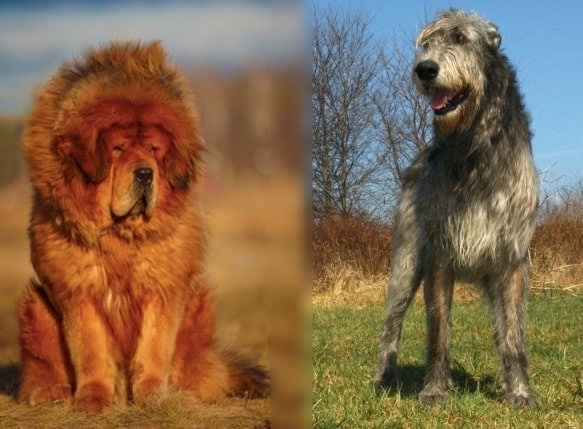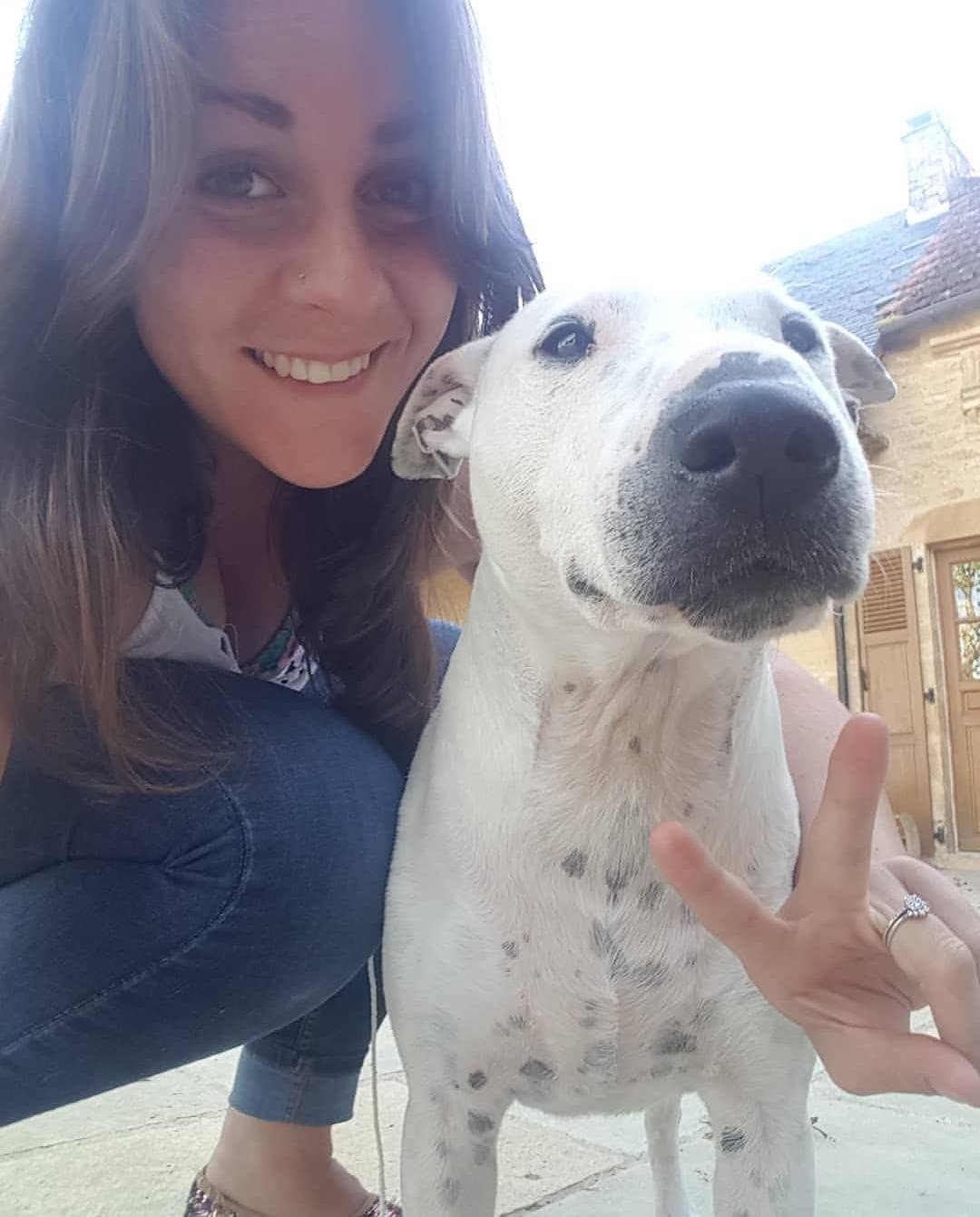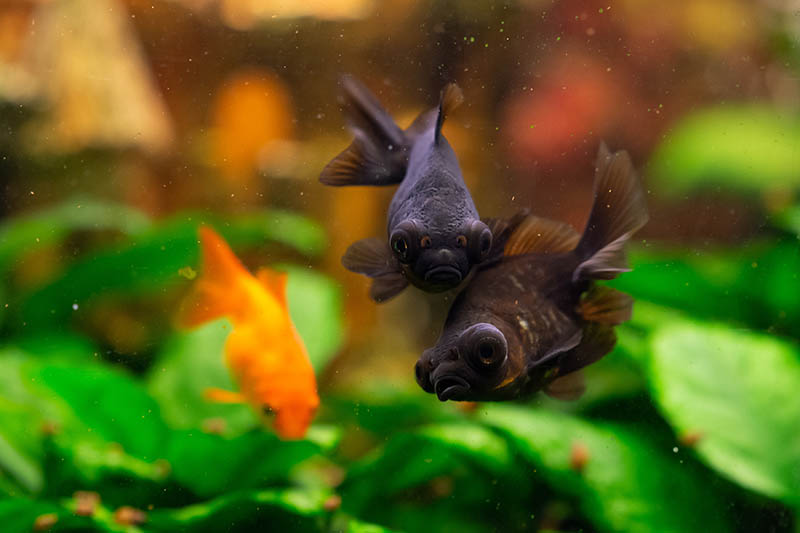German Shepherd vs. Pitbull: The Differences (With Pictures)

Updated on
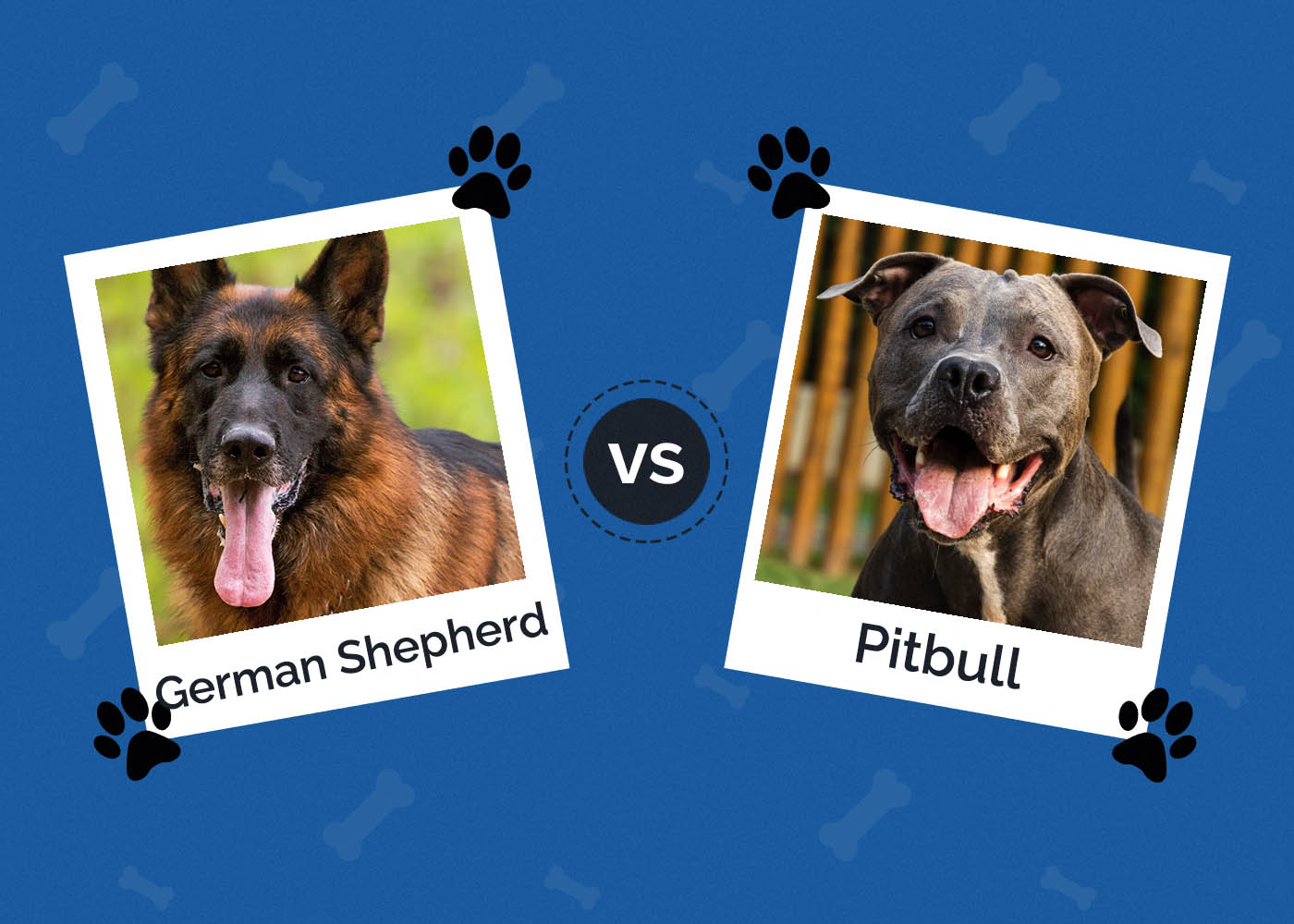
If you’re wanting to adopt a dog to protect your home or provide a companion to your family, then German Shepherds and Pit Bulls are likely to be two of the primary breeds you’ll consider.
While they’re equally fantastic for both of those aims, these are very different dogs, and you should understand how they compare to one another before making your final decision.
In the guide below, we’ll take you through the most important things to know about both dogs, so you can be sure to bring home the perfect pet for your household.
Before we begin, though, we should note that many people use “Pit Bull” to describe all manner of dogs. For this guide, we’re only using the term to refer to the American Pit Bull Terrier.
Visual Difference
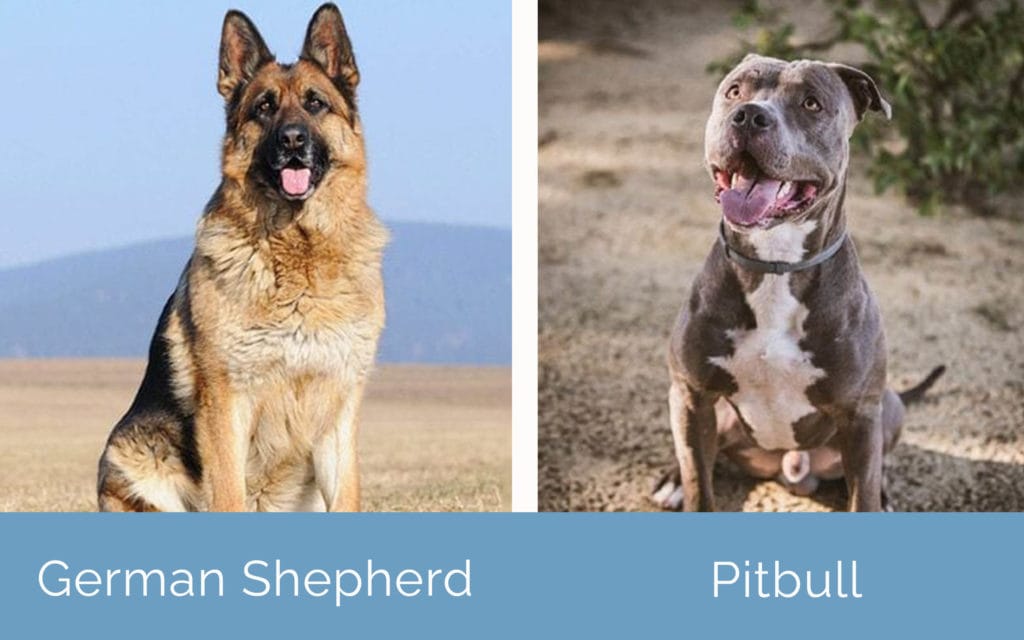
A Quick Overview – German Shepherd vs Pitbull
The German Shepherd and the Pit Bull have a lot of similarities, but they do have their set of unique characteristics. Let’s break it down.
- Average Height (adult): 21-26 inches
- Average Weight (adult): 75-95 pounds
- Lifespan: 10-14 years
- Exercise: 2+ hours/day
- Grooming needs: High (weekly)
- Family-friendly: Yes
- Dog-friendly: Often
- Trainability: Excellent, highly intelligent
- Average Height (adult): 19 inches
- Average Weight (adult): 50 pounds
- Lifespan: 13 years
- Exercise: High needs
- Grooming needs: Low to moderate
- Family-friendly: Yes
- Dog-friendly: Prone to aggression
- Trainability: Difficult & necessary
German Shepherd – History
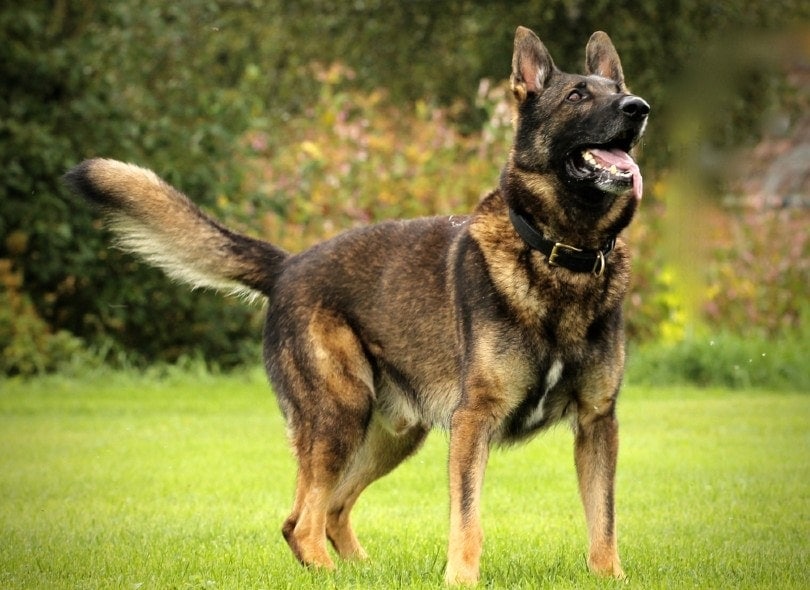
To understand the history of this breed, you first need to understand that there were German dogs that were used for shepherding long before the German Shepherd was ever officially a thing. These dogs comprised a wide range of breeds, including some native to Germany, France, and Italy.
Around 1890 C.E., the Phylax Society was formed in Germany with the aim of standardizing dog breeds native to that country. While the Society wouldn’t ultimately succeed in this aim, it would raise awareness of the need for standardized breeding, and about a decade later, efforts would begin to create the prototypical German shepherding dog.
Breeders focused on power, intelligence, stamina, loyalty, and beauty. One breeder, in particular, a man named Max von Stephanitz, led the charge to create this new dog, and by the 1920s, the dog we know as the modern German Shepherd was officially born.
The breed’s abilities were quickly recognized, and the military soon began to use them for all manner of applications, from hunting fugitives to guarding bases. One of the breed’s earliest fans was a man who would later have a lot of influence over the German military — Adolf Hitler. Don’t hold that against the dogs, though.
Pit Bull – History
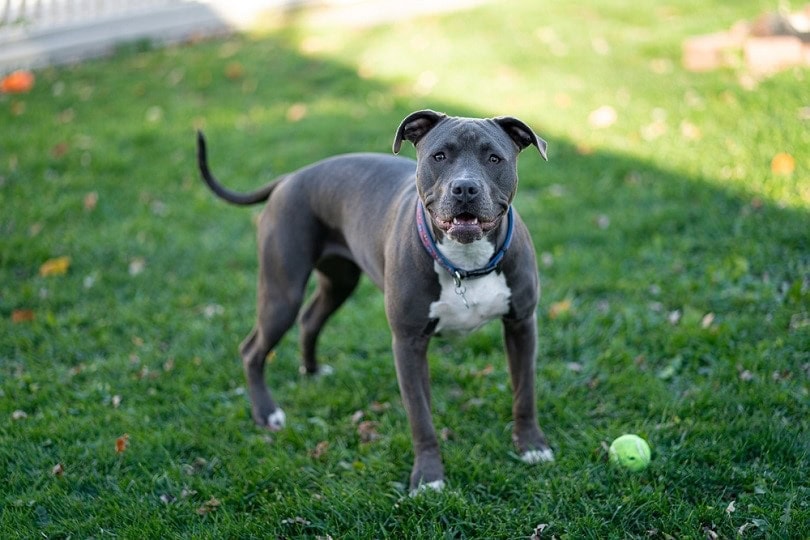
While Pit Bulls were never associated with Nazis, their history is nevertheless filled with barbarism and tragedy.
The breed is descended from Old English Bulldogs and Old English Terriers, two dogs that were used in bloodsports like bull and bear-baiting. As these sports became outlawed, they were replaced by dogfighting, which was easier to organize and conceal.
The animals who bred dogs for fighting rings prized traits like strength, tenacity, intelligence, and agility. Unfortunately, dog fighting — and breeding Pit Bulls for it — remains a big problem to this day.
The dogs weren’t just used for barbaric purposes, however. Many police departments used them to fight criminal activity, and they’re often used as therapy dogs. The breed also had such a good reputation for patience with children that they were often called “nanny dogs,” and they were expected to look after the kids in their household.
Aggression Issues
Both of these breeds have reputations for potentially being dangerous and aggressive. It’s not clear to what extent those reputations are deserved, however.
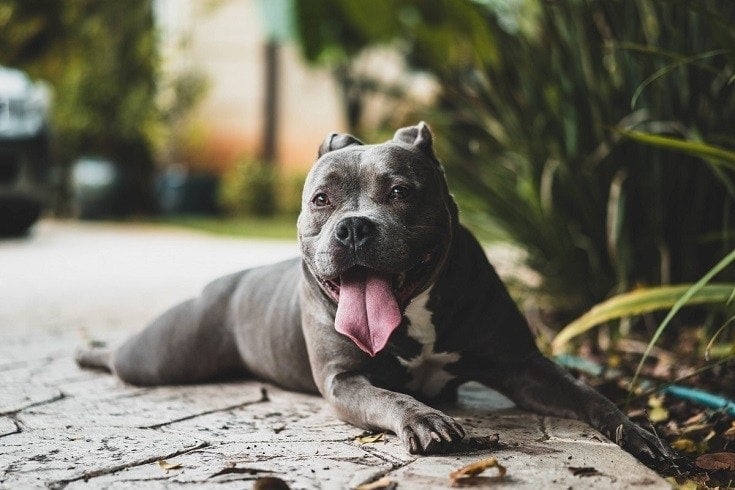
Studies, including a famous one from the Centers for Disease Control, have shown that Pit Bulls and German Shepherds (along with Rottweilers) make up a disproportionate amount of dog bite fatalities. Those same studies have admitted that they have serious flaws, though, and that you should be careful about drawing conclusions from them.
First of all, those statistics are reliant on eyewitness accounts of the dogs responsible, and both of these breeds are often mistaken for others. This throws every single reported incident into doubt.
Also, those statistics don’t account for mixed breeds. Any dog with even a trace amount of German Shepherd in it would then be counted towards the breed’s totals, even if there were other bloodlines present in the offending dog.
Finally, these two breeds are among the most likely to be abused or trained for nefarious purposes. That makes it difficult to say whether there’s an inherent issue in the breeds themselves, or if it’s just a case of a few abused individuals giving both dogs a bad name.
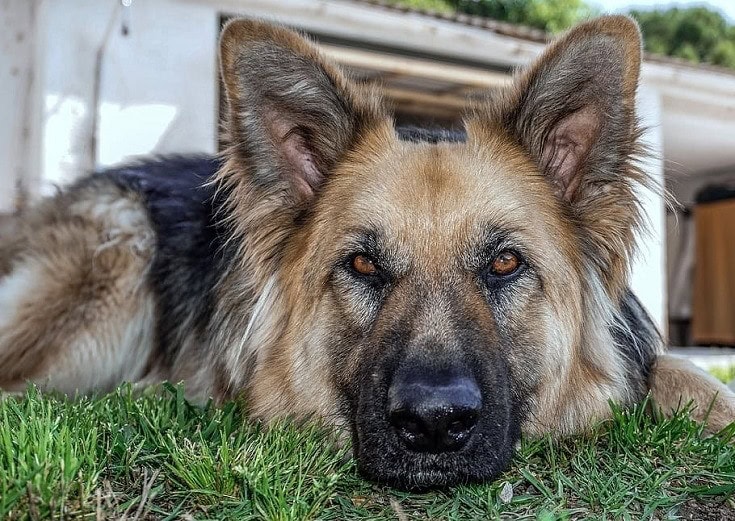
Avoiding Aggression Problems
It’s absolutely essential to train and socialize either breed thoroughly if you adopt one. While both dogs also enjoy well-deserved reputations for being sweet and loyal, they need steady and consistent training to bring out the best aspects of their personalities and to keep their baser instincts in check.
Also, do your homework before you adopt. If you’re buying from a breeder, make sure to visit their facilities in person to see how the dogs are raised and whether they’re well-cared for.
If you’re bringing one home from the pound, talk to the officials there about any personality or temperament testing that has been done on the dogs. Generally, the people who work at animal shelters will have an excellent idea of which dogs will make the best (and safest) pets.
Temperament
Both dogs are sweet and goofy, and they tend to be very energetic as well. Neither one will ever turn you down if you offer to spend the afternoon playing with them.
If they don’t get enough exercise, though, they can become restless — and they’ll often take this restlessness out on your shoes and furniture. They can be quite destructive, so you’ll need to wring every bit of energy out of them on a daily basis.
Both have strong prey drives, so they’re not ideal for homes with cats or other pets. Pit Bulls are more likely to show aggression towards other dogs as well.
However, unless there are underlying behavioral issues, both seem to adore people — especially children. You’ll still need to train and socialize them thoroughly, of course (and you should also train little ones on how to behave around dogs).
Training Styles
Both breeds are incredible people-pleasers, which makes training easier. They’ll do anything to make their masters happy, and often all you’ll need to do to reward them is offer them some praise and love.
Neither reacts well to negative training tactics like shock collars or physical punishment, though. Luckily, they’ll eat up any positive reinforcement you see fit to offer.
German Shepherds tend to pick up new commands faster than Pit Bulls, owing to their long careers as military dogs. However, they’re also insatiable when it comes to learning new things, so you’ll likely have to spend more time training them anyway.
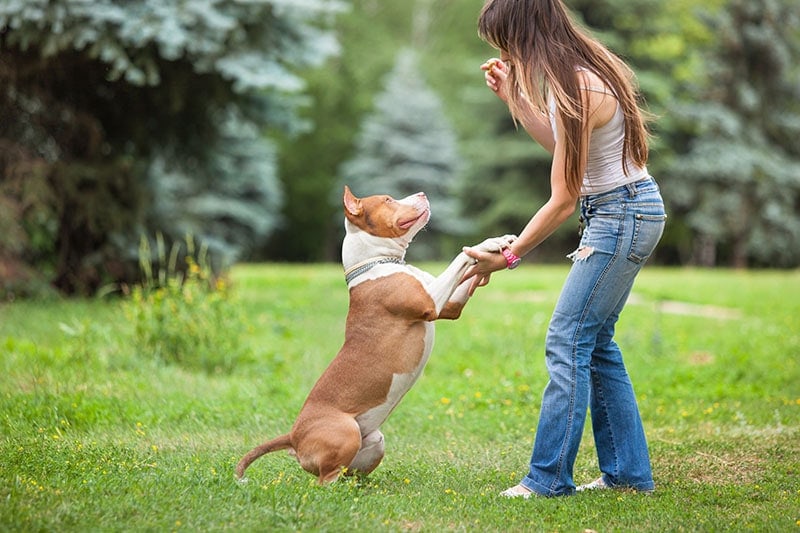
Exercise Requirements
As stated above, plenty of exercise is essential — if you value your belongings, anyway.
Daily walks are critical, and you should also stimulate their minds with regular training sessions. You can also invest in puzzle toys, and both breeds do well in agility competitions and the like.
Just be aware that these dogs can get fairly big, and they develop relatively slowly, so don’t push them too hard when they’re puppies, or you could injure their joints as a result.
Size Differences
German Shepherds tend to weigh more (about 77 pounds compared to the Pit Bull’s 50), but that weight is also more evenly distributed. They’re long, lanky dogs, whereas Pit Bulls are compact and powerful.
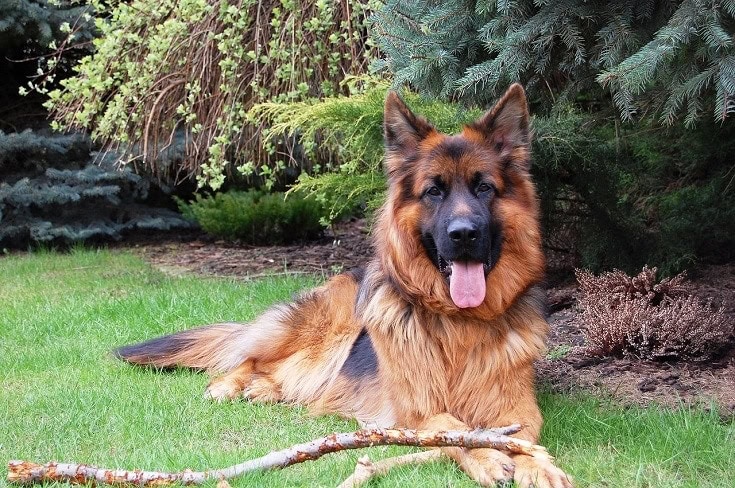
The Shepherd is less likely to try to challenge you physically, so you shouldn’t need to worry about issues like leash-pulling as much. Instead, they’ll try to outsmart you at every turn. Pit Bulls, on the other hand, will test your strength if not properly trained.
Shepherds are also a bouncy breed, like big, fluffy Tiggers. They love to run and jump, whereas the Pit Bull’s physicality is more grounded and straightforward.
Health Issues and Lifespan
The lifespan for both dogs is in the 10-14 year range, and they both have their fair share of health problems.
Shepherds have butts that are low and tucked-in, and this can lead to a host of spinal issues later in life. They’re also prone to hip and elbow dysplasia, as well as various eye diseases.
Pit Bulls often suffer from hip dysplasia as well, especially if allowed to become overweight. They’re notorious for having skin and food allergies, though, so be prepared to feed your dog a specialized diet and spend lots of time tending to his skin.
Friendliness
This category obviously depends in large part on how well each animal is socialized and trained.
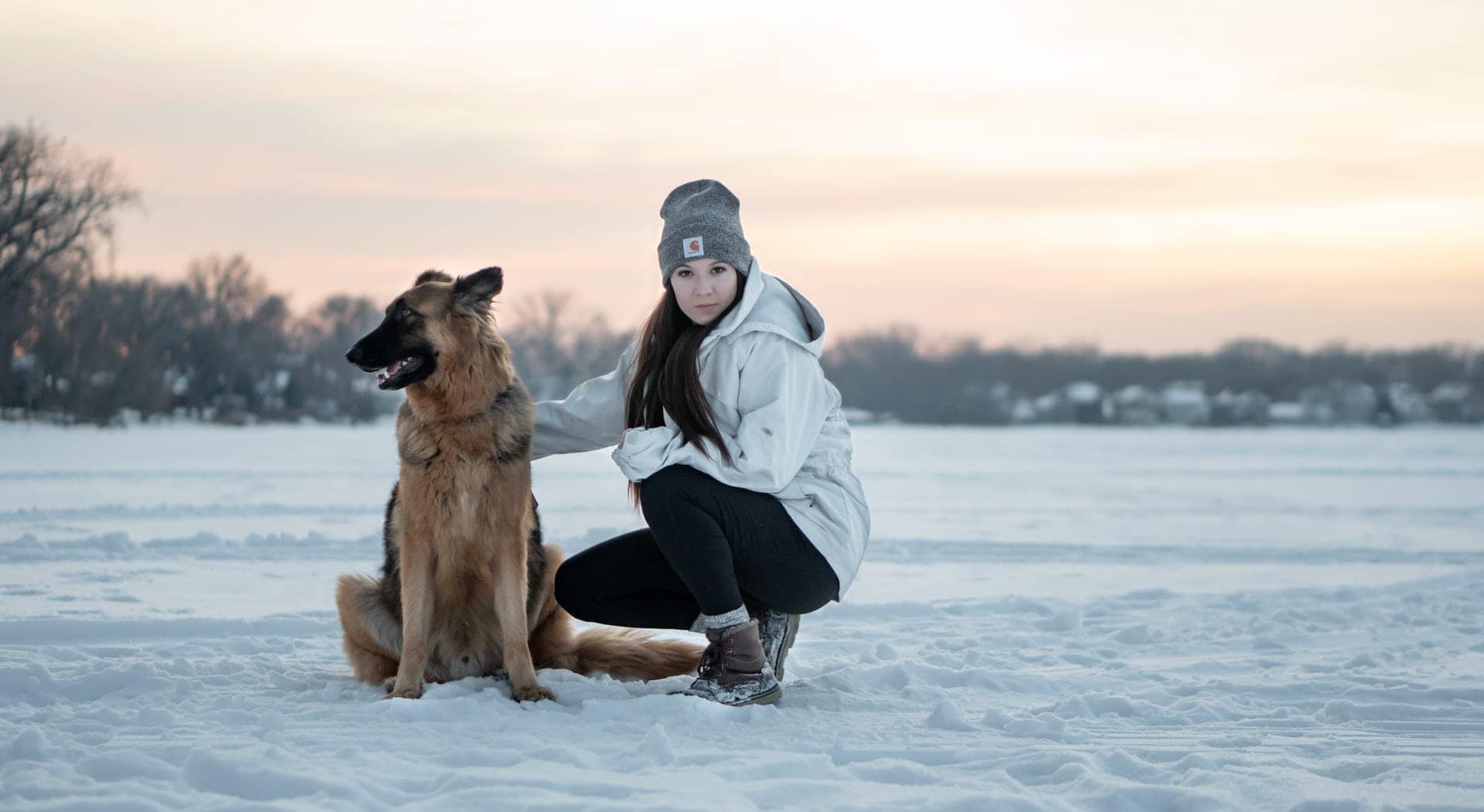
However, both breeds can be incredibly friendly and affectionate. Shepherds can quickly be convinced to trust strangers, and once they do, they’ve found a friend (and playmate) for life.
Pit Bulls are less trustworthy of people they don’t know, but they make up for it by being incredibly attached to their families. They consider themselves lapdogs, and they love nothing more than to sneak in a lick or two of your face when you’re least expecting it.
Intelligence
Pit Bulls are considered to have average intelligence. This isn’t a dumb breed by any means, but they’re not going to astonish you with their mental acuity, either.
Shepherds, on the other hand, are one of the smartest breeds on the planet. They love to learn and figure out new things, and they respond just as well to mental stimulation as they do physical exercise.
These intelligence differences often manifest themselves in how the dogs behave while alone. Pit Bulls will likely resign themselves to their environment, with little thought to what might be beyond their immediate surroundings.
German Shepherds love to explore and test their surroundings. This makes them accomplished escape artists, so make sure you have a tall, secure fence before leaving them alone in the backyard.
Grooming Requirements
Pit Bulls have short, sleek coats, and they require little more than the periodic once-over with a slicker brush. They don’t need more than the occasional bath, either.
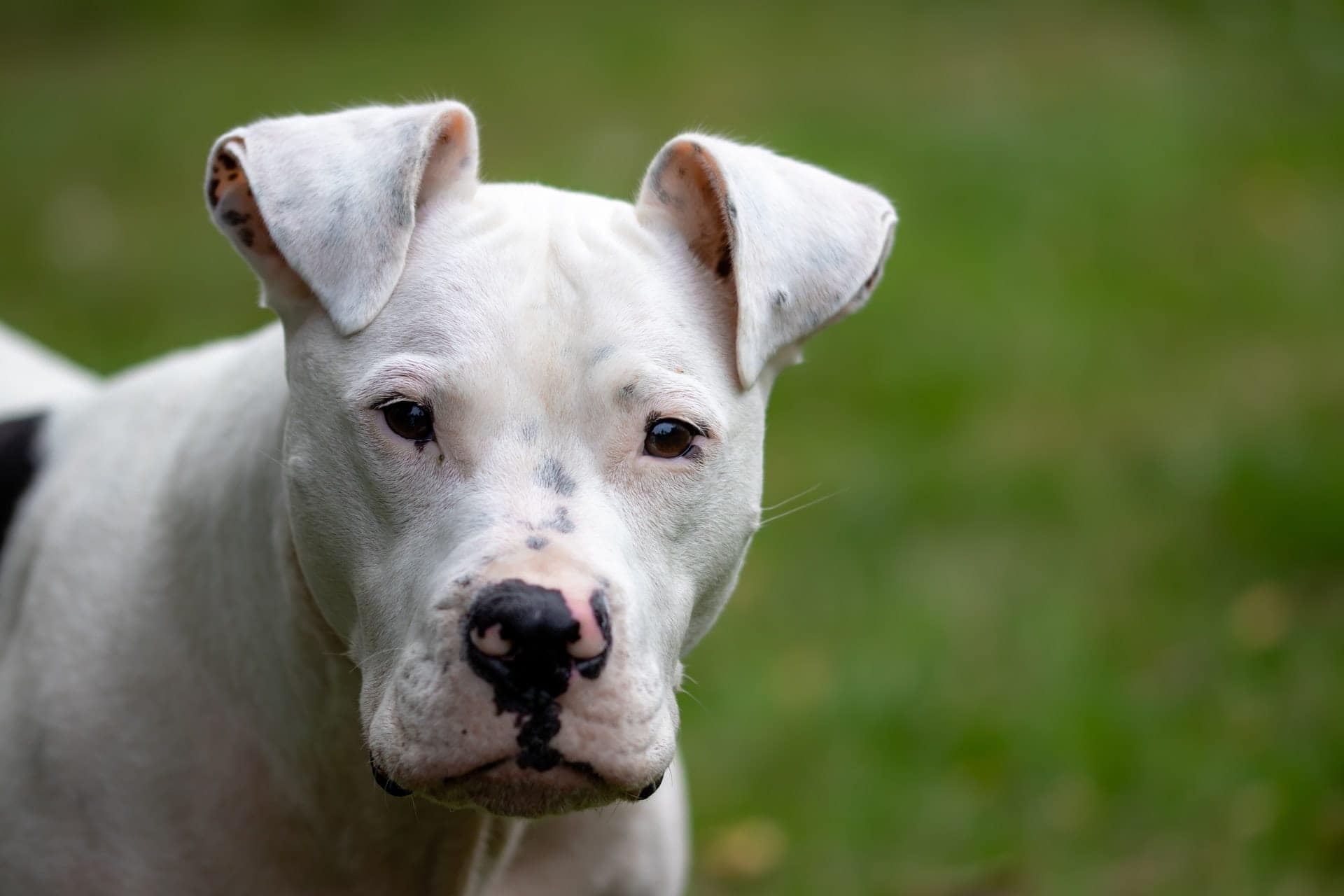
German Shepherds are at the opposite end of the spectrum. They have long, thick coats, and you’ll quickly discover your entire home will be covered in hair as soon as you let one inside.
You’ll have to brush them thoroughly and often, or else resign yourself to being perpetually covered in dog fur. Also, they need more frequent bathing, especially since their curiosity often leads them to roll in things you wish they wouldn’t.
Other Issues
Both dogs are often considered “dangerous breeds,” and as a result, you may see your insurance premiums go up if you adopt one. If you’re renting your home, your landlord may also forbid you from owning either breed.
Certain jurisdictions forbid Pit Bull ownership entirely, so check your local laws before you bring one home.
Frequently Asked Questions
Which is better for families with small children?
If properly trained and socialized, both breeds tend to do well with kids. However, you should never leave kids unattended with any dog, regardless of the breed.
That being said, German Shepherds tend to be more disinterested in children, whereas Pit Bulls often dote on them. It’s up to you whether you’d prefer a dog that ignores your kids or one that clings to them.
Does one make a better therapy dog than the other?
Both are commonly trained to be therapy animals.
Generally speaking, German Shepherds are easier to train for complex tasks, so they may be a better choice for users with lots of specialized needs. Pit Bulls tend to be more laid back, though, so they may be the more comforting companion.
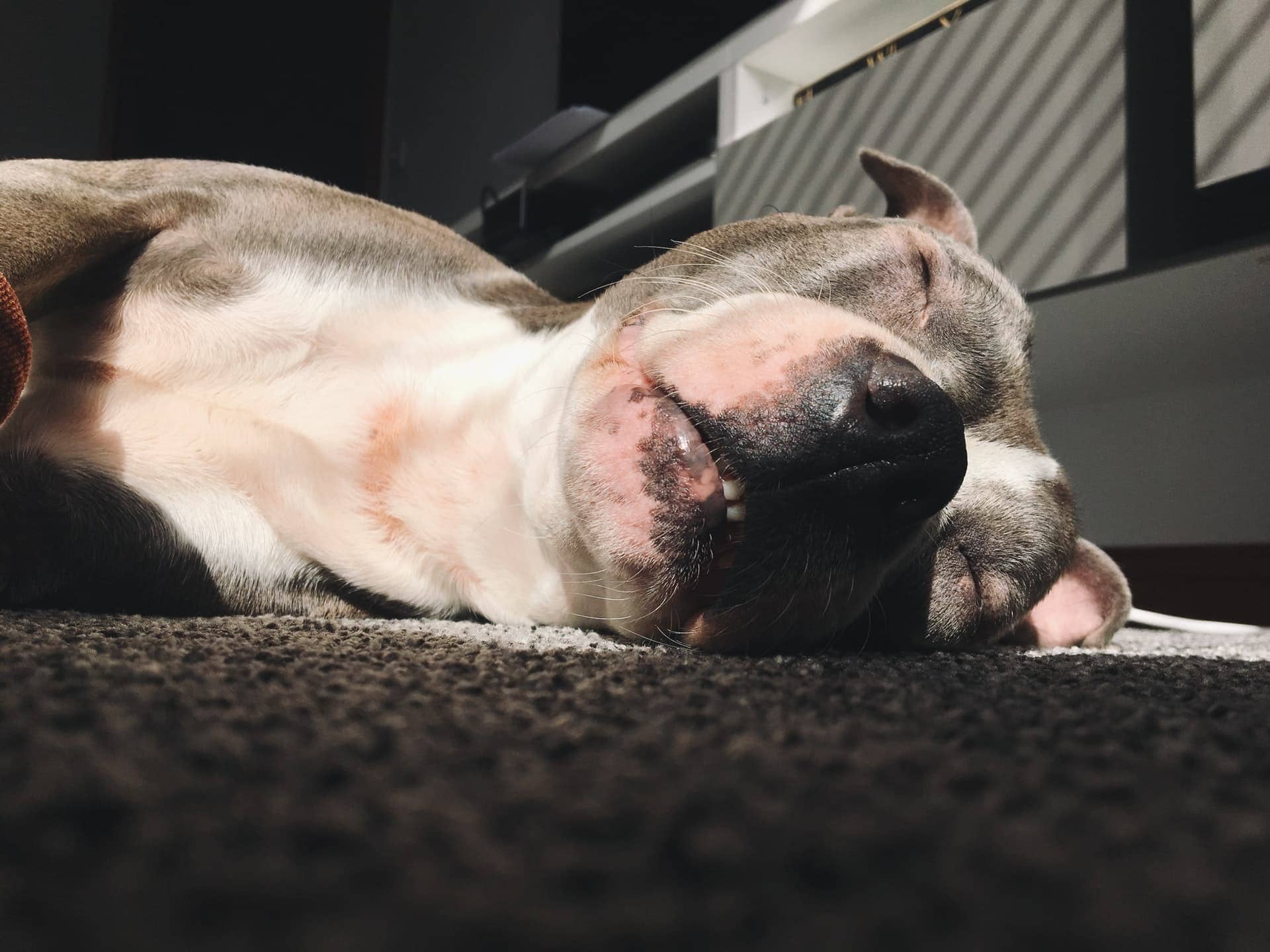
Which breed is more expensive to own?
Both are fairly inexpensive, as far as larger dogs go. You’ll need to feed each quite a bit, although German Shepherds will likely eat more.
Shepherds are also prone to more (and more costly) health problems, so expect higher vet bills with that breed. Both are equally likely to cause your insurance premiums to spike, but they may go up even higher with a Pit Bull.
Overall, the costs should be comparable but expect to pay a bit more over the lifetime of the animal with a German Shepherd.
How much do they cost to adopt?
If you’re buying one, the costs vary wildly, depending on the animal’s bloodline and the reputation of the breeder.
Typically, though, German Shepherds are in the $700 to $1,200 range, whereas Pit Bulls can cost anywhere from $800 to $2,000.
It should be easy to find one for much cheaper than that at your local animal shelter, though, as most pounds are full of both breeds. Pit Bulls are especially ubiquitous, and along with Chihuahuas, they make up the bulk of most dogs in shelters today.
What should I look for in a puppy?
If you go to a breeder, look for the things we already mentioned: quality of facilities, how the animal is treated, how they respond to the breeder, etc.
You want a breeder that seems like they really love the dogs, rather than one that’s just viewing them as a paycheck. The dogs should return that love in kind, and it should be readily apparent to visitors.
As for the dogs themselves, you want to make sure they’re well-fed and cared for, and that they’re confident and curious without being aggressive. Bring your kids along, too, so you can see how the animals respond to little humans.
You can interact with dogs before adopting them at shelters too, and we encourage you to do so (along with your family). However, understand that shelters are extremely stressful environments for dogs, so you may not get an accurate picture of the dog’s personality.
We recommend talking to the people at the facility to get their thoughts. They should have a much better idea of the animal’s characteristics, and they can help you find one that’s perfect for your family.
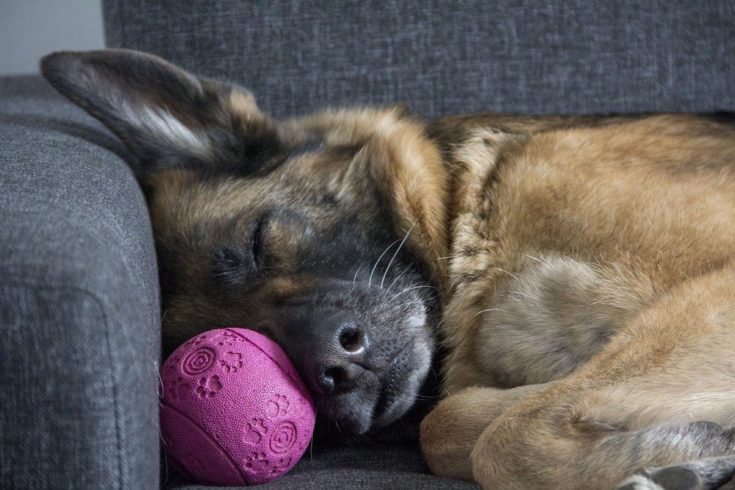
So, Which One Should I Choose?
Both the German Shepherd and Pitbull can make fantastic pets, as they’re both loyal and filled with personality. Ultimately, it depends on what you’re looking for in a dog, as well as what commitments you’re willing to make.
If you’re not going to do the hard work of training and socialization, you shouldn’t get either breed. But if you’re dead set on one, when comparing the German Shepherd vs Pitbull, we’d recommend the German Shepherd, as it’s more likely to take any aggression out on your shoes instead of the neighbor’s kids.
That being said, if you want a dog that doesn’t require constant stimulation, go for the Pit Bull. They need plenty of exercise, true, but they’re also happy to curl up on the couch with you (or on you, more likely) afterward. By contrast, Shepherds are constantly looking for stimulation.
Also, if you care about the opinions of strangers, understand that you’ll get some nasty looks if you’re walking a Pit Bull down the street. Misperceptions about the breed are strong and far-reaching, so expect to have to defend your dog’s honor on a regular basis.
If you put in the time and effort necessary to raise the animal right, you should be thrilled with either the German Shepherd or Pitbull. But if it’s truly going to come down to a coin flip, there are a lot more Pit Bulls in shelters that need you than there are German Shepherds.
Featured Image Credit: (L) Osetrik, Shutterstock | (R) Diego Thomazini, Shutterstock






